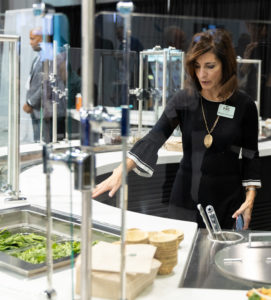written by Marsha Diamond
 NEW YORK, N.Y. – We know planning and actions are required in the journey back to thriving in a new reality. Parts of the world that have already opened have given us a glimpse of our own future, including:
NEW YORK, N.Y. – We know planning and actions are required in the journey back to thriving in a new reality. Parts of the world that have already opened have given us a glimpse of our own future, including:
• no shared community food in break rooms;
• no more communal snacks;
• more scheduled meetings (to include people working from home);
• more hand sanitizers;
• constant sanitization;
• contactless payments, ordering and check ins;
• robotics sanitizing and cleaning;
• people limited on elevators/no talking in elevators;
• more use of stairways; and
• partitions between desks.
Other recommendations will include: adding privacy curtains near the front door; removing carpet to cut down on contamination; and UVC lights to inactivate bacteria and viruses on skin, clothing, and goods in as little as 20 seconds. Mandatory employee daily surveys about flu symptoms may also become common.
These pandemic precautions are likely to make employees feel micromanaged, and this human element will require sensitivity. Employers will need to find ways to empower their people to step up with confidence within the business culture.
Moving forward, wellness must become part of the business strategy. Instead of keeping customers “safe,” consider changing the message to keeping customers “well.” Leverage the wellness message through your delicious food coupled with the operational changes you need to make for COVID-19.
Make sure customers know exactly what you are doing to keep them well. Tell customers how you are keeping employees well and minimizing environmental risks. If your business strategy includes keeping customers and employees well, make sure your customer knows.
Make use of social media platforms, videos, and in-store signage to communicate with customers and foster transparency. Everything is going to be about trust and transparency.
It is your mission to open and operate in compliance with state mandates, and provide the best customer experience. Take the time to go through the process as a customer would, from arrival, to restroom, and departure. Step back and walk through the front-of-the-house and back-of-house operations.
Questions to ponder:
• What types of materials for seating?
• Should community tables go away?;
• What table spacing is appropriate?
• Will public spaces be social spaces?
• What type of lighting will play a role in sanitation?
• How can ventilation be improved?
• How will you set up high traffic areas?
• will rooftop bars mandate six feet of spacing?
• How much outside seating will be available?
• How can bartenders decrease their risks via distance, rail partitions, and breathe guards?
• What menu limitations and modifications are necessary?
• What types of technology (robotics, AI) can ease the labor situation?
• What types of mobile technology for ordering/payment/food lockers is available?
• What types of back-of-house handwashing sinks, sanitary storage of masks, gloves, and front of house sanitizing stations are necessary?
• Which staffing models will work best?
 Independent restaurants can go into this reactivation like a start-up. Be flexible, creative, and nimble and figure out a way to use the infrastructure you have to make money. If that means you have to pivot to run online delivery, grocery pick-up, or curbside meal service—that’s what you should do. Focus on your core business, but diversify and find revenue in other ways. There are resources to help.
Independent restaurants can go into this reactivation like a start-up. Be flexible, creative, and nimble and figure out a way to use the infrastructure you have to make money. If that means you have to pivot to run online delivery, grocery pick-up, or curbside meal service—that’s what you should do. Focus on your core business, but diversify and find revenue in other ways. There are resources to help.
Restaurants and hotels, like all businesses, are going to have to be nimble, creative, flexible, and receptive to feedback from customers. Think about launching new offerings, amenities, or services. The businesses that will struggle the most are the ones that try to maintain their pre COVID-19 business models at all costs. This pandemic is a moment for our industry to evolve.
Dealing with the new reality takes strategies, courage, and realistic goals so that customers and employees feel safe and well. It many ways, it will be a restart. I can’t wait to get out there to experience the food, hospitality, and people in our industry.
Marsha Diamond, MA, RDN, is president and CEO of Diamond Approach, a foodservice marketing and sales consulting company. See www.marshadiamond.com for more info. Follow her to keep up to date on the industry at Twitter and LinkedIn.
